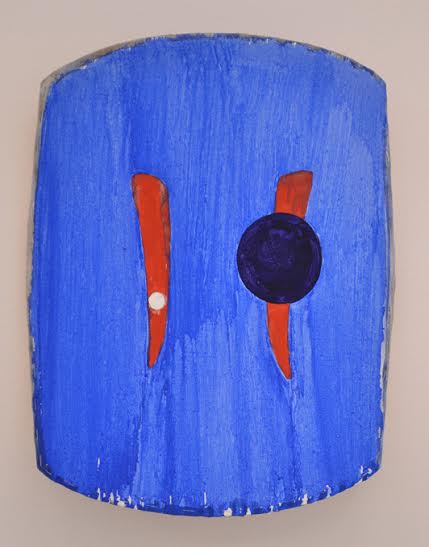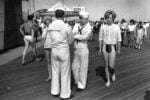Der Beste Anfang – Il Miglior inizio

L’avanguardia è sempre un’istanza di novità che muta la forma, trasforma il linguaggio e che si pone come il Der Beste Anfang – il miglior inizio, assumendosi l’assurda responsabilità di essere “necessaria ed indispensabile” non solo per se stessa ma per tutti.
Comunicato stampa
L’avanguardia è sempre un’istanza di novità che muta la forma, trasforma il linguaggio e che si pone come il Der Beste Anfang – il miglior inizio, assumendosi l’assurda responsabilità di essere “necessaria ed indispensabile” non solo per se stessa ma per tutti.
Klaus Rinke è uno degli artisti che meglio incarna il valore dell’Avanguardia, praticando con radicalità assoluta il miglior inizio. Egli si pone il dovere di un continuo aggiornamento formale e linguistico che raramente un artista riesce a mantenere per tutta la carriera con la sua stessa tensione e costanza. Egli sottopone la propria arte ad un forte rinnovamento che lo ha portato dal lavoro fotografico con cui è diventato noto negli anni sessanta, passando dalle installazioni oggettuali, fino ai dipinti recenti dove la forma e il colore tornano ad imporsi come un paradigma di novità.
Nella lunga attività artistica di Marco Cingolani invece, il miglior inizio si è sempre confrontato con i cambiamenti sociali. Nell’installazione “Duchamp discount: Il mercato del concetto” del 1989 la riflessione sul valore feticistico della merce si formalizza nel falso e nella ripetizione standardizzata del simile, vero discount formale delle idee come substrato del Postmoderno. Sempre in Cingolani i valori della statistica e del dato matematico si impongono nelle grandi tele dedicate ai Grafici Cartesiani del 1987, costruendo una mistica della statistica stessa e preconizzando il mantra dell’algoritmo e dei big data che sembrano guidare ogni nostra scelta. In “Vox Populi” ed “Opus dei” questi valori vengono iconicizzati su un asse cartesiano come nelle interviste ai personaggi famosi.
Al contrario Ron Gorchov pratica l’avanguardia della fedeltà ad una scelta esistenziale di riduzione formale e di moltiplicazione sensoriale. La forma personalissima del supporto delle sue opere, aggettante e simile ad un torso umano, costruisce lo spazio concreto del farsi dell’arte. Uno spazio immutato nei decenni che registra con accuratezza il mutare del gesto dell’artista che, per ogni nuova opera, cerca il migliore inizio; ancora un nuovo modo per definire sempre la stessa cosa: se stesso. Non si tratta di un solipsismo dell’arte, ma della migliore scoperta dell’Avanguardia: il gesto, il corpo dell’artista come primo protagonista dell’arte.
Infine il miglior inizio di Thomas Helbig è una Stimmung di uno spazio, dove segno e colore diventano attori sensibili dell’immagine. Il pittore tedesco conserva il sublime incanto della natura, come potenza minacciosa rispetto alla nostra esistenza, dipingendo l’estensione e l’illimitatezza senza appoggiarsi su un facile naturalismo. Helbig, da vero pittore d’avanguardia, sente la responsabilità del segno e del colore, non praticando il disincanto e il decoro, bensì l’incantamento di uno spazio nel quale i materiali dell’arte realizzano, ancora, Der Beste Anfang.
The Avant-garde is always an instance of novelty, that changes form, transforms the language and present itself as – Der Beste Anfang – The best beginning, taking the irrational responsibility to act as a “necessary and essential force”, not only for itself but also for everyone and everything.
Klaus Rinke is one of the artists who best personifies the value of the Avant-garde. He works in a radical way not dogmatic or stationary, but in dialogue with the historical and social instances that are in flux. Klaus Rinke in fact is the best example of a life totally dedicated to the Avant-garde: he submits his art to a continuous renewal. This renewal started from his photographic work, with which the artist has become known in the sixties, and then moved to the installations, and the recent paintings, where the form and the color returned to establish themselves as a new paradigm.
In the long artistic career of Marco Cingolani, his work has always had a confrontation with social changes. In the installation called “Duchamp discount: il mercato del concetto”(concept market) of 1989 the reflection is formalized in the false and standardized repetition of the same object, a real formal discount of ideas that arises as a substrate of the Postmodernity. We can find a similar reflection looking at the large canvases dedicated to Cartesian charts of 1987, where the values of statistics and mathematical data built a mystique of calculation predicting the mantra of the algorithm and big data that seems to guide our choices. In “Vox Populi” and “Opus Dei” these values become icons of a Cartesian axis as in the series of his interviews with celebrities.
Ron Gorchov practices the Avant-garde of loyalty to an existential choice based on a formal reduction and multiplication of senses. The typical support of his artwork, that resembles a human bust, builds the concrete space of Art making itself. A room unchanged in the decades that accurately records the changing of the gesture of the artist who reiterates the same concept: himself. This is not a solipsism of art, but the best rediscovery for the Avant – garde: the gesture, the artist’s body as the first protagonist of Art.
Thomas Helbig’s Best beginning is on the other side a Stimmung of a space, where sign and color become the main character of the paintings. The German painter preserves the idea of the sublime fascination of nature, as a menacing power. Helbig, as a true Avant-garde painter, feels the responsibility of sign and color, not practicing disenchantment and ornament, but the enchantment of a space in which the materials of art realize, once again, Der Beste Anfang.
Marco Cingolani
Nato nel 1961 a Como, vive e lavora a Milano, / Born in 1961 in Como, Italy, lives and works in Milan.
Tra le principali mostre personali e collettive / Solo and group exhibitions include: Galleria Continua, S.Gimignano; Musée d’Art Contemporaine di Gent, Belgio; Museo Pecci, Prato, Italy; Galleria Nazionale d’Arte Moderna, Roma, Italy; 53esima Biennale di Venezia, Italy; PAC, Padiglione d’arte contemporanea, Milano, Italy.
Ron Gorchov
Nato nel 1930 a Chicago, Illinois, vive e lavora a Brooklyn, New York / Born in Chicago, Illinois in 1930; lives and works in Brooklyn, New York.
Le sue opere sono incluse in molte importanti collezioni / Gorchov’s paintings are included in many prominent collections: Everson Museum of Art, Syracuse NY; Guggenheim Museum, New York City; Metropolitan Museum of Art, New York City; Museum of Modern Art, New York City; The Art Institute of Chicago, Chicago, IL; The Denver Art Museum, Denver, CO; The Detroit Art Museum, Detroit, MI; The Nelson-Atkins Museum of Art, Kansas City, MO; Whitney Museum of American Art, New York City.
Thomas Helbig
Nato nel 1967 a Rosenheim, vive e lavora a Berlino / Born 1967 in Rosenheim, lives and works in Berlin.
Tra le principali mostre personali e collettive / Solo and group exhibitions include: Tate Modern, London; Rubell Family Collection, Miami; Bortolami Dayan, New York; Saatchi Gallery, London , Museo Pecci, Prato, Italy.
Klaus Rinke
Nato nel 1939 a Rosenheim in Wattenschëid, Germania / Born in Wattenschëid, Ruhr District, Germany in 1939.Tra le principali mostre personali e collettive / Solo and group exhibitions include: Documenta V, Documenta VI, Kassel,Germany; Museum of Modern Art (MoMA), New York, USA; Venice Biennale ’78, Venice, Italy; Centre Georges Pompidou, Paris, France; Tate Gallery, London, England.
Le sue opere sono incluse in molte importanti collezioni tra cui / Rinke’s paintings are included in many prominent collections such as: MoMa, Museum of Modern art, New York, USA; National Gallery of Art, Washington, D.C., USA; The Tate Modern Museum, London, England; Staatgalerie, Stuttgart, Germany.



